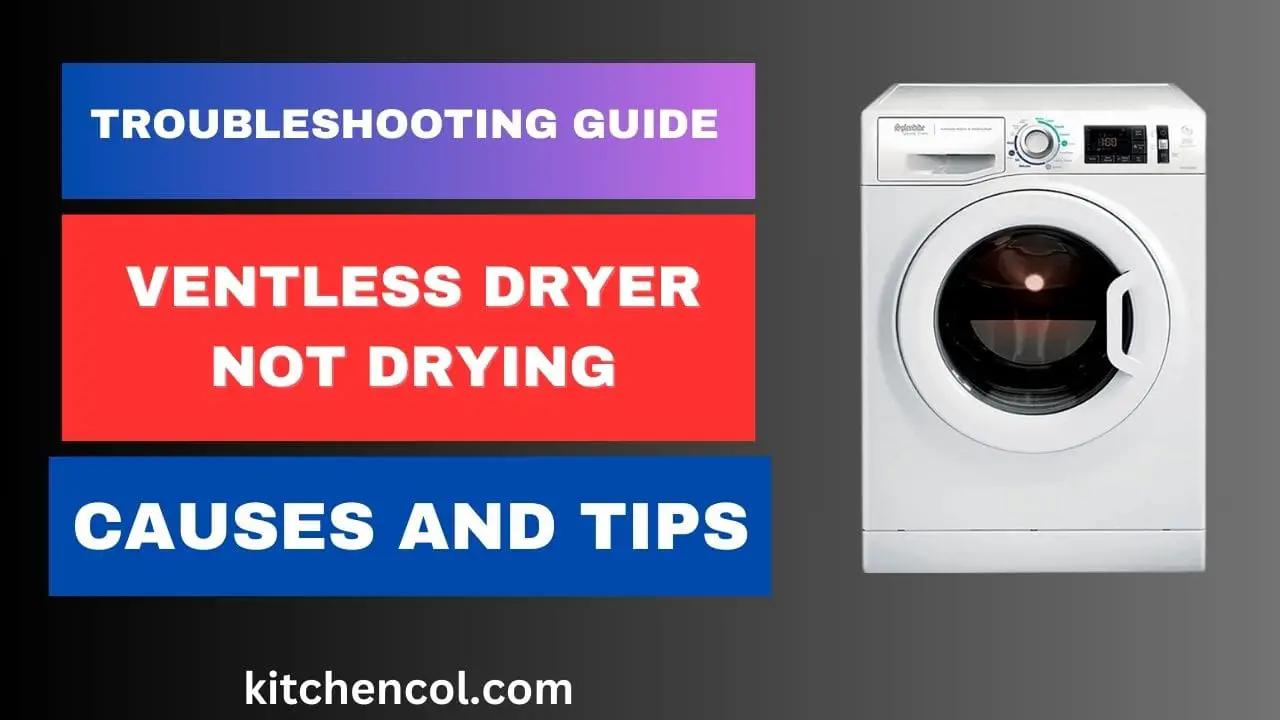A laundry routine disrupted by a ventless dryer failing to dry clothes can be frustrating. These modern marvels, designed for efficiency and convenience, sometimes encounter hiccups that impede their effectiveness. Understanding the nuances of ventless dryers and the common reasons behind their inefficiency is key to resolving these issues.
In this guide, we’ll explore the world of ventless dryers, uncover the reasons they might not be drying your clothes effectively, and offer troubleshooting steps to get them back to optimal performance. So, if you’ve found yourself with damp garments after a cycle, fear not! Let’s delve into the solutions and tips that can revive your ventless dryer and restore smooth sailing to your laundry routine.
Understanding Ventless Dryers
Ventless dryers, a modern laundry solution, operate differently from traditional vented dryers. They are designed to function without the need for a vent to expel moist air outside. Instead, they rely on alternative methods to manage moisture within the unit.
A. How They Work
- Condenser Dryers: These units use a condensing system to remove moisture from damp clothes. The warm air inside the dryer passes through the clothes, collecting moisture. This moisture-laden air then moves to a condenser where it’s cooled, turning the moisture into water. The water is collected in a reservoir or drained away, while the dry air is reheated and circulated back into the drum to continue drying the clothes.
- Heat Pump Dryers: Operating similarly to condenser dryers, heat pump dryers use a heat exchanger to cool and condense moisture from the air. However, they reheat the air using a heat pump, making them more energy-efficient than traditional condenser dryers.

B. Advantages of Ventless Dryers
- Versatility: Ventless dryers don’t require a vent, allowing for flexible installation in various spaces, even in apartments or locations without outdoor vent access.
- Energy Efficiency: Heat pump dryers, in particular, are known for their energy efficiency, as they recycle heat within the system rather than expelling it outside.
- Reduced Risk of Air Loss: Unlike vented dryers where warm air escapes outside, ventless models retain heat, potentially saving energy and maintaining a comfortable indoor temperature.
- Ideal for Small Spaces: Their compact design and diverse installation options make them perfect for small homes or areas with limited ventilation.
Understanding these differences helps users appreciate the unique mechanics of ventless dryers. However, these systems can face challenges affecting their drying efficiency, prompting the need to troubleshoot potential issues.
Common Causes of Ventless Dryers Not Drying
Despite their innovative design, ventless dryers can encounter issues that hamper their drying capabilities. For troubleshooting to be efficient, it is essential to comprehend these typical causes.
A. Lack of Proper Maintenance
- Clogged Filters or Lint Traps: Accumulation of lint and debris in filters or traps obstructs airflow, reducing the dryer’s efficiency.
- Blocked Airflow Pathways: Blockages in the exhaust hoses or venting systems restrict proper airflow, hampering the drying process.
B. Overloading the Dryer
- Capacity Overload: Filling the dryer beyond its recommended capacity impedes airflow, resulting in inadequate drying.
C. Incorrect Settings or Cycle Selection
- Wrong Drying Cycle: Selecting incorrect settings, such as low heat or the wrong cycle length, might lead to incomplete drying.
D. Issues with the Heat Source or Heating Elements
- Malfunctioning Heating Elements: Damaged or faulty heating elements can disrupt the proper heating required for drying clothes effectively.
- Heat Pump or Condenser Issues: Problems with the heat pump or condenser system in the dryer can affect its ability to remove moisture efficiently.
Understanding these potential issues can help users diagnose and address problems preventing their ventless dryers from operating at peak performance. In the following section, we’ll delve into troubleshooting steps to rectify these issues and get the dryer back on track.
Troubleshooting Steps
When faced with a ventless dryer that isn’t drying clothes properly, following a systematic troubleshooting approach can often resolve the issue.
A. Checking and Cleaning Filters and Lint Traps
- Inspect Filters and Lint Traps: Regularly examine and clean filters and lint traps before each drying cycle to ensure unobstructed airflow.
- Thorough Cleaning: Use a brush or vacuum to remove accumulated lint or debris from filters and traps to maintain optimal airflow.
B. Ensuring Proper Ventilation and Airflow
- Inspect Exhaust Hoses and Venting Systems: Check for blockages or kinks in the hoses and ensure the venting system allows proper airflow.
- Clearing Obstructions: Remove any lint, debris, or objects obstructing the airflow pathway to enhance dryer efficiency.
C. Avoiding Overloading the Dryer
- Adhere to Recommended Capacity: Stick to the manufacturer’s recommended capacity to allow adequate airflow within the dryer drum for efficient drying.
D. Verifying the Correct Settings and Cycle Selection
- Selecting the Appropriate Cycle: Choose the correct drying cycle and settings based on the fabric type and desired dryness level.
E. Inspecting Heating Elements or Heat Source
- Checking Heating Elements: Test the heating elements for functionality or signs of damage. Replace or repair any faulty elements.
- Examining Heat Pump or Condenser System: Ensure the heat pump or condenser system is functioning correctly. Clean or repair components as needed to maintain proper moisture removal.
By following these systematic troubleshooting steps, users can often identify and resolve issues hindering their ventless dryers from drying clothes effectively. If problems persist despite these efforts, seeking professional assistance may be necessary to address more complex issues within the appliance.
Tips for Preventing Ventless Dryer Issues
Regular maintenance and proper usage can significantly extend the lifespan and efficiency of ventless dryers.
A. Regular Cleaning and Maintenance Schedule
- Scheduled Cleaning: Establish a routine to clean filters, lint traps, and the dryer interior regularly to prevent clogs and ensure proper airflow.
- Ventilation Maintenance: Periodically check and clean exhaust hoses, venting systems, and condenser units to maintain unobstructed airflow.
B. Proper Loading for Efficient Drying
- Follow Recommended Capacity: Adhere to the dryer’s capacity guidelines to allow adequate space for clothes to tumble and ensure efficient drying.
- Separating Clothes by Fabric Type: Sort clothes based on fabric type and drying requirements to optimize drying efficiency.
C. Using Appropriate Drying Settings and Cycles
- Selecting Suitable Settings: Choose the right drying cycle and settings for different fabric types and laundry loads.
- Utilize Sensor Technology: If available, utilize sensor-based drying technology to automatically adjust drying time based on moisture levels in the load.
D. Regular Inspections and Maintenance Checks
- Scheduled Inspections: Conduct periodic checks on heating elements, heat pumps, and condenser units for any signs of wear, damage, or malfunction.
- Professional Maintenance: Consider scheduling professional servicing annually or as recommended by the manufacturer to ensure optimal performance.
E. Avoiding Overuse and Proper Use Guidelines
- Avoid Overloading: Resist the temptation to overload the dryer as it can hinder airflow and drying efficiency.
- Follow Manufacturer’s Instructions: Adhere to the manufacturer’s guidelines and recommendations for usage, cleaning, and maintenance.
By implementing these preventive measures and following best practices, users can significantly reduce the likelihood of encountering issues with their ventless dryers, ensuring consistent and efficient drying performance over time.
Also Read: Ventless Dryer: Efficient Pros and Cons Explained
Conclusion
Maintaining a ventless dryer’s efficiency involves regular upkeep, mindful usage, and adherence to manufacturer guidelines.
By conducting routine cleanings, loading garments properly, selecting appropriate settings, and scheduling professional maintenance, users can mitigate common issues affecting drying performance.
Implementing these preventive measures not only ensures effective drying but also extends the lifespan of the appliance.
Remember, a proactive approach to care and maintenance preserves the functionality of ventless dryers, guaranteeing smoother laundry experiences for the long haul.

My name is Manan Bukhari and I am an expert in reviewing kitchen products for years. I have a passion for testing multiple gadgets especially related to home & kitchen. I love to spend my free time in resolving issues if I face some in any of my daily use things. I have fixed multiple gadgets of my home on my own without any assistance and that thing gave me confidence to make a blog on troubleshooting of items that are for daily use to assist you folks. Even my wife praises me for having such talent. I always explore new machines on my own because this thing fascinates me.



